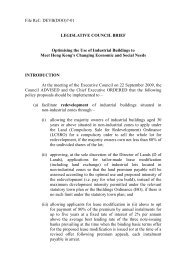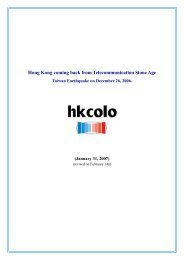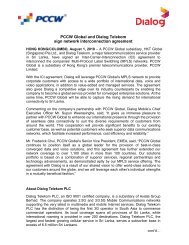You also want an ePaper? Increase the reach of your titles
YUMPU automatically turns print PDFs into web optimized ePapers that Google loves.
<strong>Telecom</strong> <strong>1980</strong> - <strong>2040</strong>
80’s Regulatory EnvironmentMost Countries <strong>Telecom</strong> was run as a state Monopolyonly substantially the USA had commenced de-regulationLittle or no competition for the provision of serviceexistedIn most cases revenues from telecom were extracted intothe various government exchequers meaning investmentin new technology was slow and minimalWorkforces highly unionised, Training was internalisedand focused on maintaining what existed as a‘mechanical art form’ rather than looking to newmethodologies, and service concepts.
What was <strong>Telecom</strong> in <strong>1980</strong>’sBeginning of the Decade• Mainly Voice telephony – copper distribution from 50vCB Strowger mechanical Telephone exchanges. Trunkroutes used analogue transmission systems using coaxial4mghz & 12 MHz, smaller systems included - 24 circuitside carrier or individual HQ analogue balanced circuitsfor radio and TV.•Telex: 50baud, 100 baud systems was the main databackbone of commerce•International leased lines for voice running Analogueover FDM (Frequency division multiplex)
Beginning of the DecadeRotary pulse decadic dialElectro magnetic bell using 25hz ring +Armature gongs. Other mechanicalContacts, gravity springs on handset rest
Transmission SystemsFirst Pulse Code Modulation digital SystemsAlthough PCM was invented in the19 th century digital line systems onlystarted to appear in the 1970’s24 channel AMI systems were installed in the 1970’sbut the <strong>1980</strong>’s saw Europe standardise using 30channel 2mbits HDB3Higher Order line systems8mbits, 34mbits, 565mbitsFirst Optical fibre systems usingmonomode and multimode
Mobile TelephonesA voice call only system using AMPSNo Texts, Wallpapers, tunes, games
Up Until the 1990’s <strong>Telecom</strong>municationsWas a mechanical world
<strong>Telecom</strong> <strong>1980</strong><strong>Telecom</strong> in <strong>1980</strong>’s being substantiallyMechanical was maintenance intensiveIn Switching centers and also in the fieldIn UK BT was the sole supplierof end User apparatus
But Then the World Changed!Governments Privatised, liberalized and deregulated thetelecom markets – initially licensing duopolies, leadingto whole spectrums of competitive markets, inc enduser appsCompetition stimulated the take up of new technologiesLiberalization & Deregulation stimulated investmentIncumbent monopolies were forced to restructure andbecome efficient business’<strong>Telecom</strong> advancement impacted other industries whowere able to expand also. <strong>Telecom</strong> changed the way theworld did business
What was the Change ? – Simples..Data is Born!Mid<strong>1980</strong>’s
PC’s were developingBasic Units with mono colour screensrunning DOS programs loaded by floppydisc. Data could be transferred point topoint. Email was closed user only. Programsinc: AppleSoft, Quattro Pro, FoxBASE,WordPerfect, Basic, Lotus 123
1990’s Saw Change AccelerateLiberalization around the globe continues – earlyadapters: USA, UK, Australia, NZ, Japan, Canada, France,Germany, Ireland. Various different models are used.GSM SIM based mobile licences are issued, mobilenetworks grow customer bases, AMPS, CDMA, GSMInternet enters the public vocabulary, email, websitesInternational cable systems using high capacity OpticalFibre cables are laid across the planetFrom 1990 to 1999, the global telecommunications marketgrew at a compound annual rate of 10.2%US$348 billion to US$835 billion. In the late 1990’s growthin capacity caused prices to fall at a rate of 20% to 40% peryear
1990’s Mobile 2G Development2G introduced a new variant of communication called SMS ortext messaging. It was initially available only on GSM networksbut spread eventually on all digital networks. The first machinegeneratedSMS message was sent in the UK on 3 December 1992followed in 1993 by the first person-to-person SMS sent inFinland. The advent of prepaid services in the late 1990s soonmade SMS the communication method of choice amongst theyoung, a trend which spread across all ages.2G also introduced media content on mobile phones. In 1998the first downloadable content sold to mobile phones was thering tone. Games were soon to follow.
1990’s WWW. InternetThe Web was invented by British scientistTim Berners Lee in 19891991 – Traffic exceeds 1 trillion bytes per month.1992 - One million hosts are connected1993 - Traffic on the Internet expands at a 341,634% annualgrowth rate.1994 - 'The Rolling Stones' broadcast the 'Voodoo Lounge tour'over the 'M-Bone'.1996 - Nearly 10 million hosts online. The Internet covers theglobe approximately 40 million people are connected to theInternet. Users in almost 150 countries around the world are nowconnected to the Internet. The number of computer hostsapproaches 10 million.1997 - 2000+ - Internet penetrates every aspect of life creating asingle Global Village of information exchange.
<strong>Telecom</strong> 2000 Thebubble burstsMarch 2000 Saw the NASDAQ lose 2,000 ptsNASDAQ Composite index, peaked at 5,048.62 (intra-day peak5,132.52), more than double its value just a year before. Thesubsequent fall killed many Internet companies and also smallertelecom companies who got sucked down when share price andinvestor confidence evaporated.In Europe the vast amounts of cash the mobile operators spent on3G licences in Germany, Italy, and the United Kingdom, for example,led them into deep debt. The investments were far out ofproportion to both their current and projected cash flow, but thiswas not publicly acknowledged until as late as 2001 and 2002.The stock market crash of 2000–2002 caused the lossof $5 trillion in the market value of companies fromMarch 2000 to October 2002.
<strong>Telecom</strong> 2000 - 2010VoIP - Has eclipsed TDM for wholesale traffic, quality is nowindistinguishable from traditional toll. Prices continue to reduce3G - Initially thought of as a white elephant has emerged as a credibleadvancement over 2G and is driving Smart Phones and TabsIntegrated Broadband – Local infrastructure now delivers, Phone,TV and Internet to householdsData Centers – Have emerged as critical wealth generators forbusiness’ to outsource hardware and systems management. Cloudcomputing will add to their businessM’Commerce & Mobile Apps – In many ways are superseding thetraditional Web and PC based servicesMultimedia – Social Networks such as Facebook, Utube are providingnew means of communication and marketingSmart Phones & Tabs – (Android/iPhone etc) Are the latestmobility tools – interestingly whilst viewed as advanced are stillin their infancy!
<strong>Telecom</strong> 2010 - 2020Imminent ChallengesSilicone Chips - are reaching the limits of Nano technologyi.e.., they cannot get any smaller as engineering is already atthe atom levelBattery Technology – Although vastly improved still iscomparatively primitive as a stored value power technology.More investment is needed in regenerative powerPower - A problem of global proportions. Heat from serversis dissipated away as a ‘problem’ through air cooling systems,yet heat is an energy source? Data Centers all ready use asmuch power as the country Sweden!
<strong>Telecom</strong> 2010 - 2020Imminent Challenges (cont)WiFi - As a local access medium, WiFi is currently underengineered. Up and down speeds are not stable and capacitydemands are set to grow not decline. Globally there is littleservice level ubiquity.Internet Backbone - Because of the variable and spikycharacteristic of Internet traffic new statistical cell capacitysystems are needed as opposed to fixed capacity systemswhich simply over load and then come back in spec whenload reduces.Traditional WireLine Voice Carriers - Need to diversify theirbusiness models as toll revenues will evaporate they musthave other services to compensate. Such as “home hosting”
<strong>Telecom</strong> 2010 - 2020Smart Phones and Tabs will grow inFeatures and power via Cloud softaccess
<strong>Telecom</strong> 2010 - 2020Credit Cards may go the way of the chequebookAs its functionality will transpose onto theHandset and Tab with proximityfeatures
<strong>Telecom</strong> 2010 - 2020CD’s will disappear from PC’s as a means of loadingSoftware – possibly USB Dongles will temporarilyReplace as Cloud computing establishes anddownload speeds over Wifi or Home Hubs increase
<strong>Telecom</strong> 2020 - <strong>2040</strong>Air Quality (weather station)Water QualityRemote SecurityGas / Co2 monitoringEnergy ManagementUtility Billing / source load,managementVisually Impaired AppsPet TrackerChildren applicationsHome safety – hazard area alertsHome Hosting (Mobile bypassrouting for Mobile devices providinghigh speed to handset/tab)Personal cloud databases for familyrecords, entertainment etc
<strong>Telecom</strong> 2020 - <strong>2040</strong><strong>Telecom</strong> CompaniesInfrastructure - There will still be a requirement for fixed andradio networks, international cables, satellites and their willstill be line plant ownership invested through telecomoperators. Data Centers will probably house the majority ofactive assets for the Application service layer.Service Applications – A whole new generation of serviceproviders will be able to offer comprehensive services butwill not necessarily be telecom companies eg. The likes of:GOOGLE, MicroSoft, Apple, FaceBook and a whole newgeneration of competitors.Payment Gateways & Finance Companies - These may alsomerge into electronic service applications beyond their corebusiness”
<strong>Telecom</strong> 1941 - 2011
<strong>Telecom</strong> <strong>1980</strong> – <strong>2040</strong>The Arrow of the futureIs fired from the Bow ofToday



![香港(中立機樓)有限公司新聞發佈[31.08.2010] HKCOLO 於香港開設 ...](https://img.yumpu.com/49478494/1/184x260/31082010-hkcolo-.jpg?quality=85)




